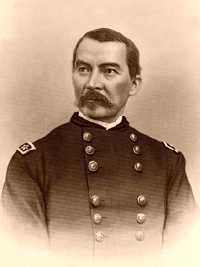 SKC Films Library SKC Films Library |
| SKC Films Library >> American History >> United States: General History and Description >> Civil War Period, 1861-1865 >> Biography, A-Z |
 Philip
Henry Sheridan Philip
Henry SheridanUnion General Philip Henry Sheridan was born on March 6, 1831. The exact place of his birth is unknown, for he was apparently born sometime between his parents' emigration from Ireland and their settlement in Somerset, Ohio. Appointed to West Point in 1848, Sheridan graduated thirty-fourth of fifty-two cadets in 1853 and was assigned to Fort Duncan, Texas, with the First United States Infantry. In late 1855 he was transferred to the Pacific Northwest, where he served until the Civil War started. Nicknamed "Little Phil" because he only stood 5 feet 5 inches tall, Sheridan became one of the top three Northern heroes of the war, along with Ulysses S. Grant and William T. Sherman. A Lieutenant when the war started, he attained the rank of Major General by the war's end. He commanded divisions at the battles of Perryville, Kentucky (October 1862), Stones River, Tennessee (December 1862), Chickamauga, Georgia (September 1863), and Chattanooga, Tennessee (November 1863). In 1864 he was made Commander of the Cavalry Corps of the Army of the Potomac in the Eastern Theater. He led a raid on Richmond, Virginia (May 1864), devastated the Shenandoah Valley (August 1864-March 1865), and helped force the surrender of Robert E. Lee at Appomattox, Virginia (April 1865). After the war, Sheridan was sent to Texas with 50,000 soldiers to threaten the French-sponsored regime of Emperor Ferdinand Maximilian Joseph in Mexico. On March 19, 1867, Sheridan assumed command of the Fifth Military District (Texas and Louisiana), with headquarters in New Orleans. An advocate for freedmen, Sheridan severely limited voter registration for former Confederates and then required that only registered voters (including black men) be eligible to serve on juries. On July 30, 1867, he removed Texas Governor James W. Throckmorton, a former Confederate, from office, saying he was an "impediment to the reconstruction of the State." Sheridan next commanded the Department of the Missouri, with headquarters at Fort Leavenworth, Kansas, where he organized a successful winter campaign led by Lieutenant-Colonel George A. Custer against the southern Cheyennes in Indian Territory (1868-1869). In 1869, Sheridan became commander of the Military Division of the Missouri, with headquarters at Chicago, Illinois. In this capacity he directed that five army field forces converge on the Texas Panhandle in what became the largest single action against the Comanches and Kiowas. Thanks to the victory of Colonel Ronald S. MacKenzie at Palo Duro Canyon on September 28, 1874, the campaign was a major success. On June 3, 1875, Sheridan married Irene Rucker, daughter of General Daniel H. Rucker. After William T. Sherman retired on November 1, 1883, Sheridan became Commanding General of the United States Army. On June 1, 1888, Congress promoted him to full General. He died of heart disease at Nonquitt, Massachusetts, on August 5, 1888, while still on active duty, and is buried at Arlington National Cemetery. His memoirs, Personal Memoirs of P.H. Sheridan, were completed shortly before his death. WEB SOURCES SEE ALSO |
| SKC Films Library
>> American History
>> United
States: General History and Description >> Civil War Period, 1861-1865 >> Biography, A-Z This page was last updated on August 05, 2017. |